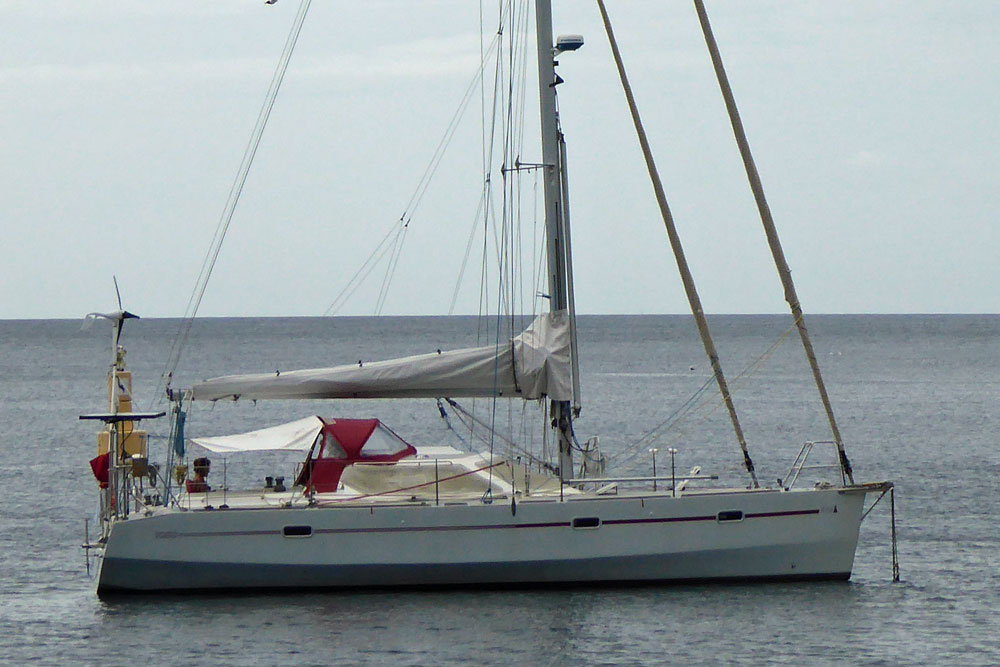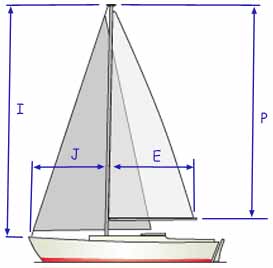- Home
- Cruising Yachts 40' to 45'
- RM 1350 Sailboat
The RM 1350 Sailboat
Specs & Key Performance Indicators
The RM 1350 sailboat, a light-displacement performance cruiser, was designed by French naval architect Marc Lombard and is constructed by RM Yachts, a shipyard located in La Rochelle, France.
 The cutter rig provides versatility in sail handling, which is advantageous in heavy weather.
The cutter rig provides versatility in sail handling, which is advantageous in heavy weather.Published Specification for the RM 1350 Sailboat
Keel & Rudder Configuration: Twin Keel*
Hull Material: Epoxy plywood
Length Overall: 13.7m (44'11")
Waterline Length: 12.8m (42'1")
Beam: 4.5m (14'9")
Draft: 2m (6'5")
Rig Type: Cutter
Displacement: 9,200 kilograms (20,282 pounds)
Ballast: Not specified
Hull Speed: 8.7 knots
Designer: Marc Lombard
Builder: RM Yachts
Year First Built: 2008
* There are two other keel options: a single fin keel and a lifting keel.
Sail Areas & Rigging Dimensions

Mainsail: 53 m² (569 ft²)
Genoa: 59 m² (634 ft²)
Solent: 31 m² (333 ft²)
Spinnaker: 150 m² (1,616 ft²)
I: 16.5m (54'2")
J: 5.1m (16'9")
P: 15.8m (51'10")
E: 5.5m (18'0")
Published Design Ratios for the RM 1350 Sailboat
The Key Performance Indicators (KPIs)
Based on the published design ratios, the RM 1350 sailboat exhibits the following theoretical sailing characteristics:
- Sail Area/Displacement Ratio (SA/D): 12.4 - This ratio indicates that the RM 1350 is somewhat underpowered, suggesting it may not have the high performance of a racing yacht but is suitable for cruising with moderate performance.
- Ballast/Displacement Ratio (B/D): Not specified - Without this ratio, it's difficult to assess the stiffness and power of the boat. However, the placement of ballast is crucial for stability and performance.
- Displacement/Length Ratio (D/L): 122 - This places the RM 1350 in the light displacement category, meaning it requires less sail area to reach its hull speed. This characteristic is beneficial for achieving good speed with moderate sail effort.
- Comfort Ratio: 20.3 - This ratio suggests that the RM 1350 has a motion comfort level associated with a coastal cruiser with moderate stability. It should provide a relatively comfortable ride in typical coastal conditions.
- Capsize Screening Formula (CSF): 2.2 - A CSF above 2.0 indicates that the RM 1350 is more suited for coastal cruising rather than bluewater passages. The boat's beam and displacement suggest it may be more vulnerable to capsizing in extreme conditions compared to designs with a lower CSF.
These ratios collectively suggest that the RM 1350 is a well-balanced cruiser, suitable for coastal sailing with moderate performance and comfort.
Here's how to calculate the KPIs yourself - without having to wrestle with the mathematics...
Design Ratios: Notes of Caution...
- The Sail Area/Displacement Ratio (SA/D): This ratio provides an estimate of the sail power relative to the boat's weight, which can indicate potential speed in various wind conditions. But it doesn't account for the efficiency of the sail plan, the rigging, or the skill of the crew. Real-world performance can vary significantly based on these factors.
- The Ballast/Displacement Ratio (B/D): This ratio gives an idea of the boat's stability and stiffness, which is crucial for handling and safety. But it doesn't consider the distribution of the ballast or the hull shape, both of which can greatly affect stability. A high B/D ratio alone doesn't guarantee a stable boat if the ballast is poorly distributed.
- The Displacement/Length Ratio (D/L): This ratio helps predict the boat's speed potential and its behaviour in different sea conditions. But it doesn't account for the hull design or the boat's overall weight distribution. Two boats with the same D/L ratio can perform very differently if their hull shapes are different.
- The Comfort Ratio (CR): This ratio estimates the boat's motion comfort in a seaway, which is important for long passages. But it doesn't consider the boat's interior layout, which can also affect comfort. Additionally, personal tolerance to motion varies, so a boat that is comfortable for one person might not be for another.
- The Capsize Screening Formula (CSF): This formula assesses the likelihood of a boat capsizing in heavy seas, which is critical for offshore safety. But it doesn't take into account the boat's handling characteristics or the skill of the crew. A boat with a low CSF can still capsize if poorly handled in severe conditions.
General Limitations
- Static Nature: These ratios are static measurements and don't account for dynamic factors like wave action, wind gusts, or crew actions.
- Simplification: They simplify complex interactions into single numbers, which can be misleading. Real-world performance is influenced by a multitude of factors that these ratios can't fully capture.
- Context: The context in which the boat is used (e.g., coastal cruising vs. offshore racing) can greatly affect how these ratios should be interpreted.
In summary, while these ratios provide valuable insights into the theoretical performance characteristics of a sailboat, they should be used as part of a broader assessment that includes practical experience, sea trials, and expert advice.
This article was written with the assistance of Gemini, a large language model developed by Google. Gemini was used to gather information, summarize research findings, and provide suggestions for the content and structure of the article.
Recent Articles
-
Sailboat Wheel Steering Maintenance & Inspection Checklist
Dec 30, 25 02:32 PM
Keep your vessel’s helm responsive and reliable with our expert maintenance checklist. Master cable tensioning and system inspections to avoid mid-passage failures. -
Modern Boat Electronics and the Latest Marine Instruments
Dec 20, 25 05:27 PM
Should sailboat instruments be linked to the latest boat electronics as a fully integrated system, or is it best to leave them as independent units? -
Hans Christian 43: Classic Bluewater Cruiser & Liveaboard Sailboat
Dec 10, 25 04:37 AM
Explore the Hans Christian 43: a legendary heavy-displacement, long-keel sailboat. Read our in-depth review of its specs, design ratios, and suitability for offshore cruising and living aboard.












